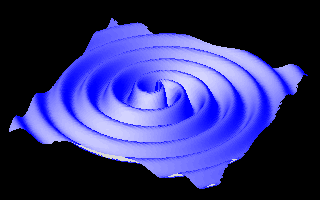Gravitational Waves

The picture displayed above are gravity waves produced by two neutron stars orbiting a center point directly between them, known as the center of mass.
In order gain a rudimentary understanding of gravitational waves, you must first learn about spacetime itself.
In Newtonian physics, the laws of physics that govern our everyday lives on earth, position is described as a vector, a quantity with magnitude and direction, in 3D space and is independent of time. In Einstein's General Theory of Relativity, space and time are combined into one object called spacetime. The spacetime coordinate system has four coordinates; three coordinates for space and one for time. Unlike Euclidean space, the coordinate systems for spacetime have curvature. This means that the trajectory of a particle moving in a straight line will be curved because the spacetime that it travels through itself is curved. The straightest possible paths these particles travel are the paths due to minimal gravitational influence.[2]
The video below illustrates the effect mass has on the curvature of spacetime.
[3]
Now, picture a situation similar to the one in the video, except replace the sun and the earth with two dense neutron stars orbiting each other. This warping of spacetime propagates outward in the form of a wave, as illustrated in the top picture. A gravitational wave is longitudinal, similar to that of sound waves. This means that the crests and troughs of the waves are compressions and dilations of spacetime itself. Brian Cox, professor of Particle Physics at The University of Manchester frustratingly explains to a layman camera man what a gravitational wave is.
[4]
Next
